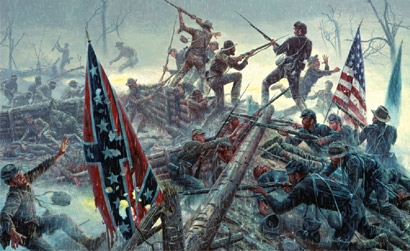With vibrant colors stretching more than 5 feet high and 8 feet wide, “Joseph’s Bridge” by Red Grooms is a monumental sight. It has a wall inside the Nassau County Museum of Art (NCMA) all to itself, in the Louis and David Lerner Gallery. Made out of acrylic and wood, this work of art is a 3-D tribute to the Brooklyn Bridge and pays homage to the East River’s interaction with man.
Grooms’ comic-book style and love of urban life led to this 2004 creation, complete with the River, a multicolored skyline, the backside of a bicyclist and the famous suspension bridge. Grooms, an American painter, sculptor and artist, is just one of the 41 artists featured at the NCMA’s latest exhibition.
“We have some permanent collection now, in the library,” Constance Schwartz, the curator for this season’s exhibition, says, pointing to the photography images hanging from the museums’ walls. “[But] right now, the ‘Sea’ is in the whole building.”
She referring to “The Sea Around Us,” the museum’s current showcase, which features more than 80 ocean-inspired pieces, from paintings to historical objects. Named after a book by Rachel Carson, the exhibit embraces the author’s theme of water with its dark blue walls.
The NCMA has been serving the community since 1989 as a not-for-profit institution. Nestled on 145 acres of land, garden and sculpture, the museum displays four annual exhibits with its art constantly on rotation.
“Long Island is such a water-based place that we decided we would like to do an exhibition and show how artists interpret it, the sea, in so many different ways,” Schwartz says.
The exhibition, Schwartz notes, is divided into four categories: vistas, ports, leisure and tragedy. The collection’s pieces reflect the respective themes, illustrating everything from calm landscapes to dangerous waters. The exhibit also includes a scale model of the S.S. United States and relics from the 19th and 20th centuries.
“These artworks that embrace the theme of water portray the historical and social significance presented by oceans, lakes and rivers as an ongoing frontier for man,” Schwartz summarizes in the exhibition’s catalog. “[It’s] an odyssey in which each generation strives to expand upon our previous understanding and experience.”
Featuring both American and European art and objects, “The Sea” has artistic creations from the 19th through 21st centuries. It encompasses several artistic movements, including expressionism, surrealism, abstract expressionism, and abstraction, Schwartz says.

“Tragedy” works, like “Ship In Trouble” and “Shipwreck,” are also on display, along with depictions of oil spills.
“Whenever you see a painting that is done in Europe you usually find some sort of relic, some sort of castle, some sort of statuary,” Schwartz muses. “With America, during the 1800s, it was all wilderness—gorgeous, gorgeous wilderness. The Hudson River painters captured that wilderness, and it was very luminescent and transcendental and very close to God.”
The Hudson River school painters, a New York City-based group of artists, were American landscape painters active during the mid-19th century. The Catskill Mountains and the Hudson River, as showcased by this exhibit, inspired the paintings’ transcendent beauty. “The Sea” pays tribute to these valley works with art by Jasper F. Cropsey and Thomas Moran, two of the movement’s most important figures. The serene “Newport Seascape” (1856), and the more turbulent “The Much Resounding Sea” (1884), are included in the mix.
“You have a very interesting cross section [of art],” Schwartz says. And among the exhibition’s beauty is a fair share of tragedies.
James Edward Buttersworth’s “Ship in Trouble,” Robert L. Newman’s “Shipwreck” and William Bradford’s “Locked in Ice” represent the dangerous side of the open blue. A portion of the exhibit casts a light on oil spills, a topic all the more relevant following recent events on the Gulf Coast.
Behind the scenes of this seamless presentation is careful planning. Showcases such as “The Sea” can take a year to coordinate, with curators negotiating loans with lending institutions and private collectors in the United States. Twenty-nine lenders contributed to this season’s exhibition and along with the canvases come some rules.
“If you’re looking to get paintings from other museums, there is a specific kind of time limit that they’re looking for and you have to adhere to that,” Schwartz says. “Otherwise you won’t get the paintings.”
With this time limit in mind, coordinators are making the most of their latest show. Upcoming programs at NCMA include a Private Tea and Tour of the Exhibition on Aug. 25.
The Sea’s Currents
Running alongside “The Sea Around Us” is the “Currents” exhibition, featuring work by artists Benjamin Edwards, Jessica Jackson Hutchins and Tom Sanford.
“We reserve one gallery for contemporary art, which is more cutting edge,” Constance Schwartz, curator for “The Sea Around Us,” says. “[We] show the up-and-coming artists that have already made a reputation for themselves. So this has become a very exciting gallery.”
Among the pieces in the NCMA Contemporary Gallery is “Worship,” a busy 54-inch-by-84-inch bird’s eye view of a city; “Bouquets,” a fusion of several mediums on paper; and several portraits of celebrities made with oil on canvas mounted on wood.
“It’s always something thought provoking, to put it mildly.” volunteer Helen Manta says about the gallery.
Both “The Sea Around Us” and “Currents” are open until Sept. 12, 2010.
In addition to these seasonal showcases, the museum provides classes for the community year round. Regarded as one of the country’s largest and most important suburban art museums, NCMA consists of the former Georgian mansion, now named for art collectors Arnold and Joan Saltzman, a children’s center and an educational center. The children’s center is currently under renovation, Schwartz says, to create a bigger space with a new façade.
For more info on NCMA’s current exhibition and activities, visit www.nassaumuseum.com/default.php






